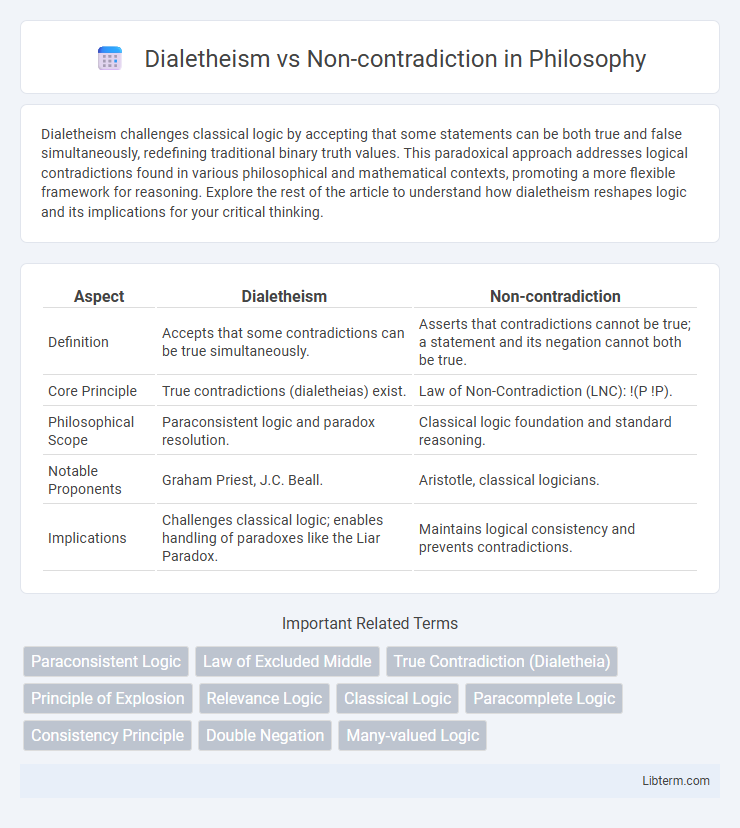Dialetheism challenges classical logic by accepting that some statements can be both true and false simultaneously, redefining traditional binary truth values. This paradoxical approach addresses logical contradictions found in various philosophical and mathematical contexts, promoting a more flexible framework for reasoning. Explore the rest of the article to understand how dialetheism reshapes logic and its implications for your critical thinking.
Table of Comparison
| Aspect | Dialetheism | Non-contradiction |
|---|---|---|
| Definition | Accepts that some contradictions can be true simultaneously. | Asserts that contradictions cannot be true; a statement and its negation cannot both be true. |
| Core Principle | True contradictions (dialetheias) exist. | Law of Non-Contradiction (LNC): !(P !P). |
| Philosophical Scope | Paraconsistent logic and paradox resolution. | Classical logic foundation and standard reasoning. |
| Notable Proponents | Graham Priest, J.C. Beall. | Aristotle, classical logicians. |
| Implications | Challenges classical logic; enables handling of paradoxes like the Liar Paradox. | Maintains logical consistency and prevents contradictions. |
Introduction to Dialetheism and Non-Contradiction
Dialetheism challenges the classical Law of Non-Contradiction by asserting that some statements can be both true and false simultaneously, particularly in cases involving paradoxes like the Liar Paradox. The Law of Non-Contradiction, foundational in classical logic, maintains that no proposition can be both true and false at the same time in the same context. Dialetheism introduces a nuanced approach to truth values, expanding traditional binary logic to accommodate contradictions without collapsing into logical triviality.
Historical Background and Philosophical Context
Dialetheism challenges the classical law of non-contradiction, which asserts that contradictory statements cannot both be true simultaneously, a principle rooted in Aristotelian logic from ancient Greece. Historically, dialetheism gained prominence through 20th-century philosophers like Graham Priest, who argued that some contradictions, known as true contradictions or dialetheias, exist in certain logical and philosophical contexts. The philosophical context of dialetheism intersects with paraconsistent logic, which rejects explosion and allows contradictions to coexist without triviality, contrasting with traditional non-contradiction that underpins much of Western metaphysics and epistemology.
Defining the Principle of Non-Contradiction
The Principle of Non-Contradiction asserts that a statement cannot be both true and false simultaneously, serving as a fundamental axiom in classical logic. Dialetheism challenges this principle by accepting that some contradictions can be true, proposing the existence of true dialetheias. Key to classical logic, the Principle of Non-Contradiction underpins consistent reasoning by rejecting the possibility of overlapping truth values in contradictory propositions.
Understanding Dialetheism: Accepting True Contradictions
Dialetheism challenges the Law of Non-Contradiction by asserting that some contradictions can be true, exemplified in paradoxes like the Liar Paradox where a statement can be both true and false simultaneously. This philosophical position contrasts with classical logic, which strictly forbids any proposition from being both true and false. Understanding dialetheism requires rethinking traditional truth values and embracing a logic system, such as paraconsistent logic, that tolerates true contradictions without collapsing into triviality.
Key Arguments Supporting Non-Contradiction
The principle of non-contradiction asserts that a statement and its negation cannot both be true simultaneously, forming the foundation of classical logic and rational discourse. Key arguments supporting this principle emphasize the necessity of non-contradiction for coherent communication, reliable inference, and the avoidance of logical paradoxes that would otherwise render reasoning meaningless. Empirical consistency across scientific methodologies also validates non-contradiction as essential for objective truth and knowledge accumulation.
Major Arguments in Favor of Dialetheism
Dialetheism challenges the classical law of non-contradiction by asserting that some contradictions can be true, supported by paradoxes such as the Liar Paradox which expose inconsistencies in standard logic. Proponents argue that dialetheism provides a more accurate framework for understanding phenomena in quantum mechanics, semantics, and set theory where conflicting states coexist. This approach enhances logical systems by allowing true contradictions, thereby resolving paradoxes that classical logic fails to address.
Logical Systems and Paraconsistent Logics
Dialetheism challenges the Law of Non-Contradiction by accepting true contradictions, leading to the development of paraconsistent logics that allow inconsistent but non-trivial theories. Non-contradiction remains fundamental in classical logical systems, where any contradiction implies logical explosion, rendering the system trivial. Paraconsistent logics enable reasoning within dialetheic frameworks by controlling inference rules to avoid explosion while accommodating contradictory statements.
Dialetheism in Contemporary Philosophy
Dialetheism, a position in contemporary philosophy, challenges the traditional Law of Non-Contradiction by asserting that some contradictions can be true, particularly in dealing with paradoxes such as the Liar paradox. Proponents like Graham Priest argue that dialetheias enable a more nuanced understanding of logical and metaphysical issues, expanding classical logic into paraconsistent logic systems. This approach has significant implications in fields like metaphysics, epistemology, and formal semantics, where dialetheism offers alternative frameworks for reasoning about inconsistent but non-trivial information.
Criticisms and Challenges to Dialetheism
Dialetheism, which asserts that some contradictions can be true, faces significant criticisms for undermining the Law of Non-Contradiction, a fundamental principle in classical logic that states a statement cannot be both true and false simultaneously. Critics argue that accepting true contradictions leads to logical trivialism, where any statement can be proven true, thus collapsing the distinction between truth and falsehood. Moreover, dialetheism struggles to provide a robust semantics that can consistently handle contradictions without leading to paradoxes or inconsistencies in practical reasoning and formal systems.
Implications and Future Directions in Philosophical Logic
Dialetheism challenges the classical law of non-contradiction by accepting true contradictions, prompting reevaluation of foundational logical systems and expanding the scope of paraconsistent logics. This perspective offers innovative approaches for handling semantic paradoxes and inconsistency in information systems, influencing areas such as artificial intelligence and formal epistemology. Future research will likely explore the integration of dialetheic reasoning with computational models to enhance robust reasoning frameworks in uncertain or contradictory environments.
Dialetheism Infographic

 libterm.com
libterm.com